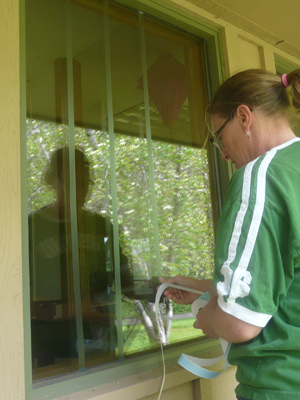By Paul Senner, ICF Field Ecology Department Intern
 I couldn’t believe what I was looking at. A painted bunting in Chicago? In January?! These birds belong in the humid swamps of the Gulf Coast, not the frigid streets of the Windy City. Yet there could be no doubt of what I was looking at, as this painted bunting was lying dead in a tray at the Field Museum among 140 other species of birds that have been collected as window kill below the skyscrapers and apartment buildings of Chicago.
I couldn’t believe what I was looking at. A painted bunting in Chicago? In January?! These birds belong in the humid swamps of the Gulf Coast, not the frigid streets of the Windy City. Yet there could be no doubt of what I was looking at, as this painted bunting was lying dead in a tray at the Field Museum among 140 other species of birds that have been collected as window kill below the skyscrapers and apartment buildings of Chicago.
As neotropical migrants pour into Wisconsin and we celebrated International Migratory Bird Day this month (May 12th) I was reminded of this painted bunting. I think we are all aware that windows pose a problem to birds, and we probably have all found dead songbirds below the windows around our bird feeders or at our work place. Yet it is easy to view these as isolated events and lose sight of the larger impact that window collisions have on songbirds as a whole. According to the Bird Conservation Network (BCN), 100 million to 975 million songbirds are killed in window collisions in North America each year. This startling statistic highlights a hard learned fact; birds do not recognize glass as a barrier.
Although the task of reducing 975 million songbird deaths may seem overwhelming, there are some very simple steps you can take to reduce the number of songbird window collisions at your house or work. Windows that reflect the surrounding trees or sky are particularly deadly to birds, so eliminating the reflective quality of your windows is a good first step to reducing bird/window collisions. The BCN recommends installing window decals or placing mesh across the outside of your windows to reduce glare, and moving house plants away from windows to make them less attractive to birds. The BCN also recommends a simple step that we can all follow to reduce bird/window collisions; don’t wash your windows during the migration season.
 Additionally scientists at The Field Museum of Chicago have documented that bright lights are disorienting to songbirds at night, and are the cause of large scale bird/window collision events. Luckily the solution to this problem is simple. In a 2001 study, researchers found that turning off the lights at night in an area of high bird window kill density reduced songbird deaths by 83%! This finding led to the start of the nationwide “Lights Out” campaign which encourages cities to turn off there their decorative lights during the summer months. So turning off the lights when you leave work or in your house at night is a great way to reduce your energy usage and protect migrating songbirds!
Additionally scientists at The Field Museum of Chicago have documented that bright lights are disorienting to songbirds at night, and are the cause of large scale bird/window collision events. Luckily the solution to this problem is simple. In a 2001 study, researchers found that turning off the lights at night in an area of high bird window kill density reduced songbird deaths by 83%! This finding led to the start of the nationwide “Lights Out” campaign which encourages cities to turn off there their decorative lights during the summer months. So turning off the lights when you leave work or in your house at night is a great way to reduce your energy usage and protect migrating songbirds!
Although the cranes species of the world are not threatened by window collisions (thankfully), we at ICF are doing our part to reduce our own impact on songbird populations. We have installed strips of non-reflective tape (we tried BirdTape available through the American Bird Conservancy) to the outside of the windows of the Field Ecology Lab (above) and on the large picture windows of the Ron Sauey Memorial Library (right). It is our hope that we can enjoy the arrival of our warblers, thrushes and vireos (or maybe a painted bunting) without worrying about finding them below our windows.
